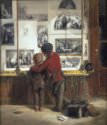Exhibited at Henry Graves, London, 1845



Exhibited at Henry Graves, London, 1845
When John Grant agreed to purchase The Greek Slave, he promised to arrange its first exhibition in London. Henry Graves was a purveyor of fine prints with showrooms in Pall Mall. The statue was shown behind a curtain that could be raised and lowered and on a pedestal that could be rotated. (This is further discussed in Martina Droth’s essay.) Graves later published two engravings of The Greek Slave, indicating that he recognized the display of the statue as a commercial opportunity.[1] A review in the Literary Gazette reveals that it was not shown alone but shared the space with a statue of a nymph by William Theed II.
[1] Martina Droth, Jason Edwards, and Michael Hatt, eds., Sculpture Victorious: Art in an Age of Invention, 1837–1901 (New Haven: Yale University Press, 2014), 246.



